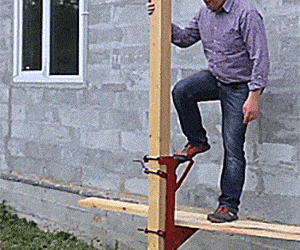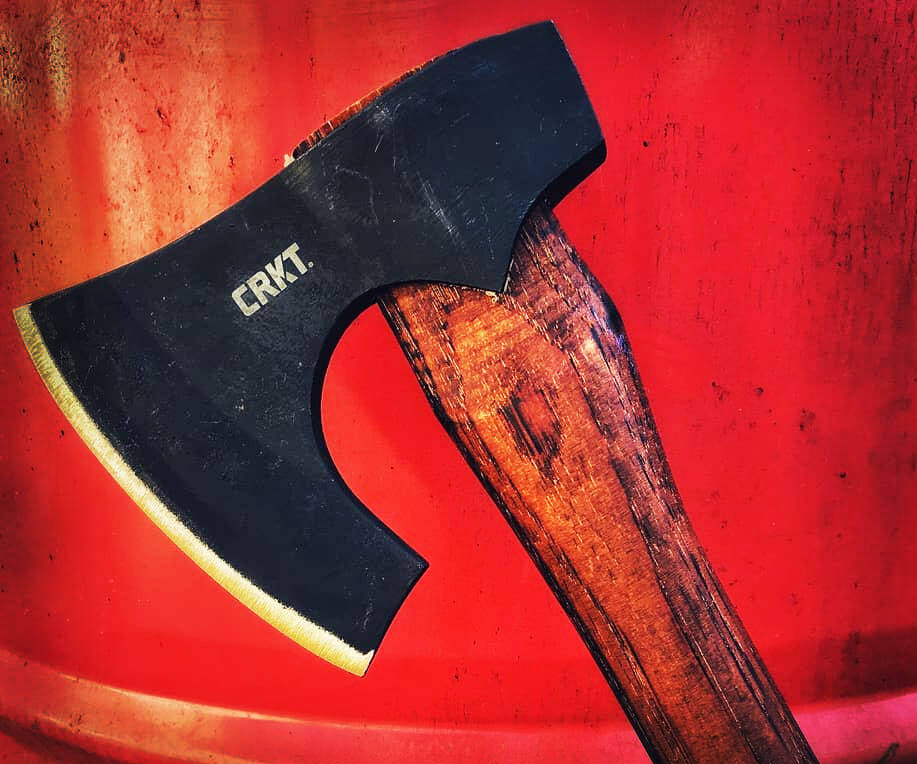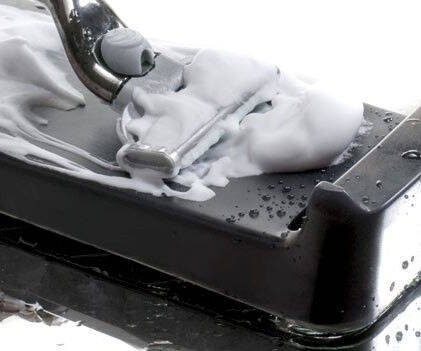Foot Pump Scaffolding Jack | |||||||||||
| |||||||||||
Product Description
Safe, portable scaffolding enables user to side and paint vertical surfaces up to 30 feet high. Pump Jack system raises workers, equipment and materials with a push of the foot and lowers by turning hand crank. Your weight does the work. It is perfect for shingling, siding, sheathing, insulating, painting, building, roofing, home repair and maintenance. Requires a minimum of two Pump Jacks to operate. Easy setup and takedown. Poles (not included) must consist of two 2x4's nailed together with 10d common nails. (refer to instructions for installation)Features
- Pump jack for low-cost, easy foot-operated jacking; secures to wood poles
- Pump jack platform accommodates two 2"x10" wood planks with Toe boards attached
- Rugged steel construction for strength, durable Powder-Coat finish to resist rust
- Country of Origin: UNITED STATES
Top Reviews
Homeowner Reviewby David K. Dalpezzo (4 out of 5 stars)
September 20, 2008
Homeowner review.
I have three of these set up on 24' long double 2x4 columns and have been using them for a week now. Here's my first impression:
- toss the included cotter pins into your parts bin and use removable clips. The whole system is designed to be put together onto the column - why they include cotter pins versus removable pins is anyone's guess.
- MAKE SURE your joints along the 2" sides of the 2x4 are smooth and without offsets. I had a 2x4 that wasn't cut perfectly true (from the factory) and the system kept hanging up on this when lowering it. It was only jutting out 1/16" too - nothing of concern when I built it. Next time I build the columns or before I use these again I'm going to run a belt sander along the edge to true it.
- The release mechanism to lower it is a pain in the butt to get to. No position you get into to be able to lower the unit is comfortable. But, it does work and I feel safe lowering it.
- Plan to tap the lowering level with a hammer to release it from the locked position. It's not always easy to move it from locked to unlocked for lowering, and more than once (but less than 1/3 of the time) I had to use a hammer to tap it out into position.
- The twist design needs updating. It's a VERY jerky ride down as the handle turns.
- The pumping process works as designed. However, as with lowering, make sure the column edges (where you can see the double 2x4) is smooth.
- The system needs guides to keep it centered. One of my columns (which were perfectly level when I set up) is gouged on the side because the pump jack "rivets" dug in when raising. It has about 5/8 of a gap on the sides of the jack, but nothing is there to maintain it in center. I am studying this now to see if there is something I can have fabricated to maintain center on my set.
I am raising my system within 40" from the top of the 24' columns. I didn't feel very comfortable with this height (my land slopes downward, so I had the height and the slope to look at, which compounded the height aspect a lot). Right now, I feel very comfortable at this height on this system, because:
- I added 2x4 "X" bracing to the bottoms of the columns. I don't lower the whole way down - I stop about 12' from the bottom and use a ladder to get me to a deck that's next to my work area.
- I added steel conduit channel (12 gauge) horizontal bracing above the "X" bracing. Overkill to be sure, but I'm not fond of heights and this added even more support to the "X" bracing. (this may be a mental stability thing - the "X" bracing was adequate, but.....)
- My scaffold is sturdy. I have two 2x10's, 12' long, with 5/8" plywood on the bottom side (to address the tension component of the bow weight will give to the 2x10's), and each 2x10 has 4" of 3M grip tape centered on them. They weigh a ton (each), but I feel very secure walking across the "bridge" and I built them to last me a lifetime.
I have the workbench attachments on my system as well. I use an aluminum scaffold on this and have been using my 8 1/2" sliding compound miter saw on it without issue. The 2x4's the workbench attachment uses for the safety railings really give me a sense of security since I know where the back edge is when I'm working.
Overall, I'm happy with this system. If I were to need it for my livlihood, I'd make some major design changes and would have a set custom built, but for homeowner or occasional contractor use, I'd buy them again.
Oh - it takes two people to put up the columns if you want to do it safely. They have some weight to them, even tho they don't look like they would. Too much weight to manhandle on a ladder (safely).
As I stated in the bracing review, there is no way I can find to have this system wrap around a corner. I have a need for this and will be building my own corner brace so I can put one of these jacks on the outside corner and laying "side B" scaffold on top of "side A" scaffold. I don't understand why a corner system wasn't produced by the manufacturer - it seems like a logical thing to have.
Pump jack
by David R. Krueger (5 out of 5 stars)
December 23, 2003
I bought these to use as scaffolding when replacing the siding on my house and have been pleased. They perform exactly as advertised. They're fairly quick to erect even though I had no help. They're quite stable with the recommended bracing and the 2204Q handrail makes them MUCH safer than a plank alone. I hate heights, so that was important for me. The only real inconvenience is the necessity of having to move the braces to work directly where they're attached or move the pump jack past a brace. Extra braces have to be used so you can attach a new brace before you remove the existing one. Since I had a lot of work to do before having to move the braces, I feel it's still a good scaffolding solution. The best advice I can offer is to think through how you plan to move or work around the braces before you put them up.
Works as advertised (revised)
by Ettienne Schwagele (4 out of 5 stars)
December 27, 2014
The instructions are unreadable, there is no spacing between words and some of the letters are printed over other letters. The jacks bind when I try to raise them, the lower part bites into the poles and the more pressure I put on the pump the deeper the bottom part bites into the poles - but the jacks refuse to climb. Yes I'm using good douglas fir poles as straight as I could find and they are plumb as can be. If I stand on the ground and work the jacks by hand then they climb the poles perfectly but as soon as there is any weight on them then they bind up. The joke is that they come down perfectly with me standing on the platform. So I have to use a ladder and raise them by hand, then get the plank in position before I can work.
***** Revised review *****
The jacks work well after I lubricated all the pivot points and the rollers. I replaced the provided split pins with hitch pins to make assembly easier.
Pump Jack Scaffold
by Glenn R. Kangiser (5 out of 5 stars)
March 28, 2010
This pump jack scaffold is a great low cost way to have scaffolding available for even longer term projects without buying or paying rent to a rental company and ending up with nothing.
You can buy the guard rail supports or just nail up handrails at about 21 and 42 inches high, to the extended scaffold posts (double 2x4 per instructions) and save the money. Be sure to block off the ends. OSHA has specs for scaffold jacks you can read online to be safe and legal (if you have employees).
Wood can be used to make the required bracing to the building every 10 feet also if desired.
The Real Truth About Qual Craft Pump Jacks that use wood supports
by Hoolihan (5 out of 5 stars)
September 30, 2013
I owe it to QualCraft to express my opinion after using their pump jacks all summer almost every day that wasn't raining too hard.
I have to admit I had a problem at first on the crank down. It was absolutely because I didn't read the directions.
The biggest problem most have is sitting on the plank and kicking the bottom hold to the down position without moving the foot pump to the up postion FIRST. "FIRST" "FIRST"
To come down:
1. Sit down on the plank where you can reach the crank. Gently move the foot pump to the up position with one hand. It moves up easily and the internal mechanism will move into the proper position inside. MAKE SURE THE PIECE THAT GOES OVER TOP OF YOUR BOOT ON THE FOOT PUMP IS AT THE 90 DEGREE POSITION SO IT DOES "NOT" GO TOO CLOSE TO THE MECHANISM WHEN IT IS IN THE UP POSITION.....and lock it up.
2. Then simply turn the crank and it will surprise you how totally easy it is to crank the plank down. Do not
crank too far down on one side so it is toooo lopsided. (that sounds silly but some people do that without
thinking sometimes. Just go a rational distance before moving to the other side to keep everything
balanced and "SAFE." Of course if you have two people you can both crank at the same time if you are not
overweight on the system.
YES, THIS IS AS GOOD A PUMP JACK AS YOU WILL FIND THAT USES WOOD SUPPORTS. If you want something more solid QualCraft has a system that uses aluminum posts and is made to use every day for years without replacing the supports. That system is absolutely excellent also if used properly.
Good Luck and have a wonderful day.....
Jimers
don't believe naysayers... its a great jack
by James C. Fletcher (5 out of 5 stars)
September 9, 2013
I recently purchased a jack to compliment the two I already have, giving me a thirty foot scaffold length using two planks between three jacks. Once you learn the nuances of how they work, you will be amazed at how easily they function. Remember, when lowering, they work best with weight on the supports.. plus making sure the lower grapple is held in a downward position. Another important detail is if you make extended poles by stagger seaming 2 X 4's to get over 16', make sure the joint is tight and in exact alignment. Otherwise, the jack climbing mechanism will get hung up on joint. Doing siding is a dream compared to ladder jacks. I love mine.
Useful for homeowner, but follow OSHA rules
by johnniemac (4 out of 5 stars)
December 12, 2004
As a homeowner I own several of these pump jacks, along with the guard rails, several braces (to be used every ten vertical feet, per OSHA), the spiked foot pole anchors, roof anchors, etc. I made the poles of douglas fir (not pine stud grade) and glue laminated them with polyurethane construction adhesive before power nailing them countersinking them every few inches.
I also bought planks of scaffolding grade (per OSHA - these are about $39 for a thirteen footer, bought locally, not through Amazon) and spaced the poles about eleven feet apart, giving me about a foot of overhang on each side (OSHA: 6 inches minimum per side). These planks are **not** supposed to be the nominal 2X12's, by the way. If you have the cash or have a longterm job to do, or have an understanding significant other who is safety conscious (use the guilt trip card), invest in an aluminum plank, as it's adjustable in its over length (width?).
I screwed the QualCraft braces and anchors into the poles after assuring the verticals and braces were all plumb and level. I personally feel that paying attention to these details when building the scaffold makes a difference in the overall dynamics of the assembly. But then again, I also feel you should not store those spiked foot pole anchors upside-down on the seat of your pick-up when not in use. All kidding aside, you really don't want this baby collapsing under you.
Perhaps a few reasons why other reviewers are having trouble cranking the pumps down: (1) clean staight douglas fir wood must be used (you gotta pick through the pile), and, (2) I found that when I leave a heavy plank on the outermost area of the work bench section of the guardrail (another QualCraft add on) while trying to lower the pump, it makes for added upper counter weight. This apparently doesn't allow the crank mechanism to bite into the wood, and thus lower the scaffold correctly. Removing the work plank before lowering the jack (careful, now) allows the pump to crank easier, IMHO. Incidently, the 2200Q differs from the home improvement store (HD) versions in that the Q has some stainless steel parts (the crank, etc.; check the photo).
Incidently, as a paralegal, I agree with another reviewer, Mr. Larsen, that Amazon's removing of the direct link to OSHA is somewhat reckless, as it may leave them open to litigation should one of their customers take a header after purchasing their equipment online from them. Has common sense also been outsourced to Bangladesh?
Do yourself and your dependents a favor, and do a web search for that OSHA gov site, then download and study their manual before buying and assembling and playing with your shiny new pump jack and scaffold. Be a nerd - like me - and follow OSHA's directions to the letter. They also have alot of photos of do's and don't's in a nifty downloadable powerpoint presentaion which makes it easier to understand their drift. For some odd unexplained reason, OSHA is a government agency that actually seems to know what they're talking about.
I'd also suggest tying yourself in, and Amazon sells the QualCraft roof and roof peak anchors along with a body harness for this very purpose. $pending a couple'a buck$ now may save you a few medical co-pays later, get it, Spider-Man??
I gave the 2200Q four stars intead of five because of the crappy slap happy paint job Qual-Craft puts on these devices, whereas they begin to rust within days of being up. I wind up buying several cans of red oxide flat rust primer spray paint to repaint them as they rust (mask off the stickers - they're all that is supplied for instructions). Also, the cheapo cotter pins that are supplied on the assembly pin thingies are garbage - go to HD and get some stainless hitch pins to replace them ASAP. They won't snap, probably are alot safer, and they're alot easier to remove upon disaasembly.
Flexible & stable work platform
by Okie Tool guy (5 out of 5 stars)
September 8, 2018
Used with paired 2/4x24' runners (be careful to fully sink to surface flush all fasteners used to tie the 2/4"'s together), at up to about 18' to install Hardie Planks with only one tradesman (with the help of great spacing guages that held the material in place until fastened). Anchored securely at top of runner and at the base for each leg. Always felt save (with a harness) and unaffected by unexpected wind gusts. Nevertheless, be sure your WC coverage is in place.
Not Bad
by Paul in NY (3 out of 5 stars)
December 26, 2008
Having never used or purchased a pump jack system before I bought the system in pieces. Nowhere that I saw are needed quantities listed.
I called the vendor to ask if the jacks themselves were priced per pair.
After they arrived I figured out that you need multiple braces. Then, I found out there were local vendors and I bought additional braces at a lower price than I paid online. The system works but after buying the jacks for $75 each, I saw Lowes has Werner jacks for $49. Oh well.
As mentioned in other reviews, the heavy red paint on the Qual-Craft parts immediately flakes off all over the place and the cotter pins are a pain.
Very good business transaction
by Rick (5 out of 5 stars)
June 3, 2019
Used product for pump jack to install vinyl siding. Very good quality
Customers Who Bought This Item Also Bought
- Metabo HPT Pneumatic Finish Stapler | 1/4-Inch Narrow Crown Staples | 18 Gauge | 1/2-Inch up to 1-1/2-Inch Staple Length | N3804AB3
- Swanson Tool CP216 Always Sharp Refillable Carpenter Pencil
- Qualcraft 2481 Ladder Hook with Wheel
- PacTool International SA90338 Gecko Gauge, LP Siding Installation Tool (1 Set)
- Qualcraft 2210 Pump Jack Anchor, for Use with 2 X 4 Double Wood Poles
- PacTool International SA903 Gecko Gauge, Fiber Cement Siding Installation Tool (1 Set)
- Qualcraft 2201 Pump Jack Brace, Steel
- Qualcraft 2204 Workbench/Guardrail Holder
- PacTool International RS501 Roof Snake, Shingle Nail Puller, Roof Shingle Installer
- ENERLITES Countdown Timer Switch for bathroom fans and household lights, 1-5-10-15-20-30 Min Settings with Manual Override, Always On Blue LED, Neutral Wire Required, UL Listed, HET06A-R, White
*If this is not the "Foot Pump Scaffolding Jack" product you were looking for, you can check the other results by clicking this link








